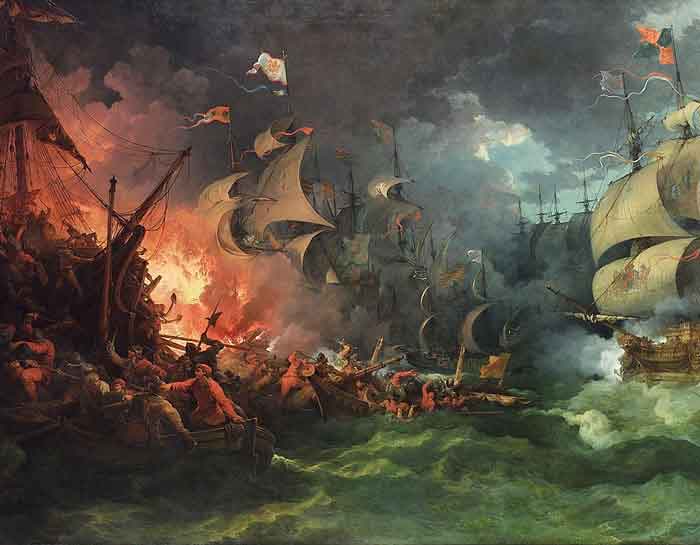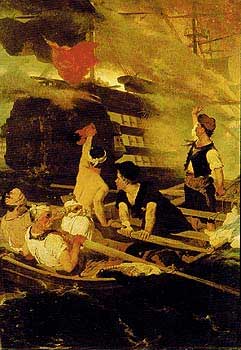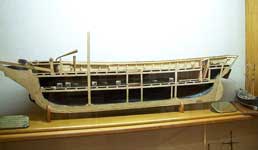.

Defeat of the Spanish Armada, 1588-08-08 by Philippe-Jacques de Loutherbourg, painted 1796, depicts Drake's fire ship attack on the Spanish Armada
A fire ship was a ship that is filled with combustibles, deliberately set on fire and steered (or, if possible, allowed to drift) into an enemy fleet in order to destroy ships or create panic and make them break formation. Ships used as fire ships were old and worn out or inexpensive vessels. An explosion ship was a variation on the fire ship, intended to cause damage by blowing up in close proximity to enemy ships.
Warships of the age of sail were highly vulnerable to fire. With seams caulked with tar, ropes greased with fat, and holds full of gunpowder, there was little that would not burn. Accidental fires destroyed many ships, so fire ships presented a terrifying threat.
With the wind in exactly the right direction a fire ship could be cast loose and allowed to drift onto its target, but in most battles fire ships were equipped with skeleton crews to steer the fire ship onto the target (the crew were expected to abandon ship at the last moment and escape in the ship's boat). Fireships were most devastating against fleets at anchor or otherwise restricted in movement. At sea, a well-handled ship could evade a fireship and disable it with cannon fire. Other tactics were to fire at the ships boats and other vessels in the vicinity so that the crew could not escape and therefore might decide not to ignite the ship, or to wait until the fireship had been abandoned and then tow it aside with small maneouverable vessels, such as galleys.
Notable fire ship attacks include:
- Francis Drake's attack on the Spanish Armada moored at Gravelines in 1588. The fire ships did no damage, but the Spanish scattered in panic and were easy prey for English ships.
- Maarten Tromp's attack on the Spanish fleet moored off the Kent coast in the Battle of the Downs in 1639. The Spanish fleet was destroyed.
- Michiel de Ruyter's attack on the anchored English fleet at the battle of Solebay in 1672 in which HMS Royal James was burned and her captain Edward Montagu killed.
- The destruction of 15 French ships of the line, including Soleil Royal, Admirable and Triomphant in 1692, after the Battle of La Hougue.
- The Russian attack on the Turkish fleet at the Battle of Chesma, 1770.
- Thomas Cochrane's attack on the French in the Battle of the Basque Roads, 1809.
- Many Greek attacks on large Turkish ships during the Greek War of Independence, 1821-1832.
Greek fire ships were manned and sailed alonside a big turkish ship (the flagship, if possible) attached to her with hooks, ropes and grips, and set on fire by the captain alone when the crew was in the escape boat. As the small fire ships were more easy to handle compared with enemy ships of the line, especialy in the coasts of Aegean Sea with the islands, islets, reefs, gulfs and straits which restrain big ships from easily moved, were a big danger in for the ships of the Turkish fleet. Many naval battles of the Greek war of indepedence won by the use of fire ships.

Nikiforos Lytras, burning of a turkish ship by Kanaris 1866-1870). 143 cn x 109 cm , 1866/1870
The use of fire ships was discontinued after the end of wooden fighting ships. An extension of the concept was however used in Operation Chariot of World War II, in which the old destroyer HMS Campbeltown was packed with explosives and rammed into the dry dock at Saint-Nazaire, France, to deny its use to the battleship Tirpitz, which could drydock nowhere else on the French west coast.
"Soon the proud fleet of the Capitan Pashaw was seen coming down toward Samos, and the Greek vessels advanced to meet it. And here one cannot but pause a moment to compare the two parties, and wonder at the contrast between them. On one side bore down a long line of lofty ships whose very size and weight seemed to give them a slow and stately motion; completely furnished at every point for war; their decks crowded with splendidly armed soldiers, and theirsides chequered with double and triple-rows of huge cannon that it seemed could belch forth a mass of iron which nothing could resist.On the other side came flying along the waves a squadron of light brigs and schooners, beautifully modelled, with sails of snowy white, and with fancifully painted sides, showing but a single row of tiny cannon. There seemed no possibility of a contest; one fleet had only to sail upon the other, and by its very weight, bear the vessels under water without firing a gun.
"But the feelings which animated them were very different. The Turks were clumsy sailors; they felt ill at ease and as if in a new element; but above all, they felt a dread of Greek fire-ships, which made them imagine every vessel that approached them to be one. The Greeks were at home on the waves,--active and fearless mariners, they knew that they could run around a Turkish frigate and not be injured; they knew the dread their enemies had of fire-ships, and they had their favorite, the daring Kanaris, with them."
Succesfull burning of ships : Place (commander):
Dar Bogaz, Gerontas and Samos (G. Batikiotis), Tenedos ( G. Bratsanos), Souda (A. Vokos), Methone (A. Dimamas), Gerontas (G. Theocharis), Mytilene (D. Kalogiannis), Ag. Marina, Samos, Tenedos, Chios (K. Kanaris), Ithaca, Messolonghi (A. Karabelas), Cavo D' Oro, Karpathos (G. Matrozos), Samos (Lekas Matrozos), Gerontas, Cavo D' Oro, Miletus and Samos (L. Mousos), Alexandria, Cavo D'Oro, Messolonghi (M. Boutis), Mytilene (K. Nikodimos), Eressos (D. Papanikolis), Methoni (A. Pavlis or Bikos), Athos, Gerontas, Spetses, Chios (A. Pipinos), Methoni, Messolonghi (G. Politis), Samos (D. Rafalias), Alexandria, Methoni, Messolonghi (M. Spachis), Methoni, Dar Bogaz (D. Tsapelis)
Naval battles
- Patras : 20.2.1822
- Spetses: 8.9.1822
- Samos : 5.8. 824
- Gerontas: 29.8.1824
- Cavo D'oro: 20.5.1825
- Souda: 2.6.1825
- Siege of Piraeus: 1.1.1827
| Ancient Greece
Science, Technology , Medicine , Warfare, , Biographies , Life , Cities/Places/Maps , Arts , Literature , Philosophy ,Olympics, Mythology , History , Images Medieval Greece / Byzantine Empire Science, Technology, Arts, , Warfare , Literature, Biographies, Icons, History Modern Greece Cities, Islands, Regions, Fauna/Flora ,Biographies , History , Warfare, Science/Technology, Literature, Music , Arts , Film/Actors , Sport , Fashion --- |
Retrieved from "http://en.wikipedia.org/"
All text is available under the terms of the GNU Free Documentation License


